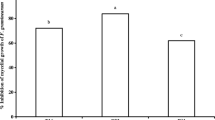Abstract
Mycelial yield and production of three trichothecenes, namely T-2 toxin, diacetoxyscirpenol (DAS) and neosolaniol (NEO) were compared in control (CS) and carbendazim-resistant strains (RS) ofFusarium sporotrichioides. Each strain was exposed to graded concentrations of carbendazim (0, 1, 2, and 4 μg/ml media) for 2, 5 and 7 days under shake-culture conditions at an incubation temperature of 25°C. Mycelial yield was significantly (P<0.001) affected by strain, carbendazim concentration and incubation time. The strain differences in mycelial mass at 2 days (P<0.05) became more pronounced at 5 and 7 days of incubation (P<0.001). However, mycelial growth differences between the two strains were greatest following exposure to carbendazim, with the effects becoming more divergent with time. Combined results for the three incubation times showed dose related effects in carbendazim inhibition of T-2 toxin production by CS isolates. In contrast, RS cultures exposed to the 2 μg/ml addition of carbendazim significantly increased T-2 toxin production (P<0.05 or better). At 1 and 4 μg/ml additions, T-2 toxin inhibition occurred but the effect was less marked than in the CS series. RS yielded more DAS than CS at 5 days (P<0.05) and at 7 days (P<0.01) of incubation. The major component of this strain difference arose from the effects of the 2 μg/ml addition of carbendazim (P<0.01). NEO production was also higher in RS than in CS, with the difference becoming progressively more pronounced from day 5 (P<0.05) to day 7 (P<0.01) of incubation. However, these differences reflected enhanced NEO output with carbendazim addition of 4 μg/ml (P<0.05) in day 5 extracts and of both 2 μg/ml (P<0.01) and 4 μg/ml additions (P<0.05) in day 7 samples. Moreover, the ratio of NEO to T-2 toxin production was affected by an interaction involving incubation time, strain and carbendazim dose (P<0.05 or better). On day 5, this ratio was greater in CS exposed to 2 μg/ml, but at 4 μg/ml, the ratio was higher in RS. It is concluded that carbendazim resistance induced genuine differences in the synthesis of T-2 toxin and NEO. It is suggested that the strain difference may reside in the conversion of NEO to T-2 toxin which may be sensitive to fungicide concentration. This would imply that carbendazim resistance induces changes in the terminal rather than initial phases of trichothecene biosynthesis.
Similar content being viewed by others
References
Parry DW, Jenkinson P, McLeod L (1995) Fusarium ear blight (scab) in small grain cereals: a review. Plant Pathol 44: 207–238
D’Mello JPF, Porter JK, Macdonald AMC, Placinta CM (1997) Fusarium mycotoxins. In: Handbook of Plant and Fungal Toxicants. Edited by JPF D’Mello, pp. 287–301. CRC Press, Boca Raton, FL, USA
D’Mello JPF, Macdonald AMC (1998) Fungal toxins as disease elicitors. In: Aspects of Environmental Toxicology. Edited by J Rose, pp. 255–291. Overseas Publishers Association, Amsterdam, The Netherlands
D’Mello JPF, Macdonald AMC, Postel D, Dijksma WPT, Dujardin, A, Placinta, CM (1998) Pesticide use and mycotoxin production in Fusarium and Aspergillus phytopathogens. Europ J Plant Pathol 104: 741–751
D’Mello JPF, Macdonald AMC, Postel D, Hunter EA (1998) 3-Acetyl deoxynivalenol production in a strain ofFusarium culmorum insensitive to the fungicide difenoconazole. Mycotoxin Res 13: 73–80
D’Mello JPF, Macdonald AMC, Dijksma WPT (1998) 3-Acetyl deoxynivalenol production in a strain ofFusarium culmorum insensitive to the fungicide difenoconazole. Mycotoxin Res 14: 9–18
Placinta CM, Macdonald AMC, D’Mello JPF, Harling R (1996) The influence of carbendazim on mycotoxin production inFusarium sporotrichioides. In: Proceedings of The Brighton Crop Protection Conference pp 415–416, British Crop Protection Council, Farnham, UK
Mead R, Curnow RN (1983) Statistical Methods in Agriculture and Experimental Biology 335 pp. Chapman and Hall, London and New York
Hollomon DW, Zhou M, Wang J, Lu Y, Ju L (1996) Selection for carbendazim resistance in Fusarium species on wheat and rice in China. In: Proceedings of The Brighton Crop Protection Conference pp 707–712, British Crop Protection Council, Farnham, UK
Moss MO, Frank JM (1985) Influence of the fungicide tridemorph on T-2 toxin production by Fusarium sporotrichioides. Trans Br Mycol Soc 84: 585–590
McCormick SP, Hohn TM, Desjardins AE (1996) Isolation and characterisation of Tri3, a gene encoding 15-O-Acetyltransferase from Fusarium sporotrichioides. Appl Environ Microbiol 62: 353–359
Jones RK (2000) Assessments of fusarium head blight of wheat and barley in response to fungicide treatment. Plant Dis 84: 1021–1030
Milus EA, Parsons CE (1994) Evaluation of foliar fungicides for controlling Fusarium head blight of wheat. Plant Dis 78: 697–699
Gareis M, Ceynowa J (1994) Influence of the fungicide Matador (tebuconazole/triadimenol) on mycotoxin production by Fusarium culmorum. Z LebensmUnters Forsch 198: 244–248
Author information
Authors and Affiliations
Corresponding author
Rights and permissions
About this article
Cite this article
D’Mello, J.P.F., Macdonald, A.M.C. & Briere, L. Mycotoxin production in a carbendazim-resistant strain of fusarium sporotrichioides. Mycotox Res 16, 101–111 (2000). https://doi.org/10.1007/BF02946109
Received:
Accepted:
Issue Date:
DOI: https://doi.org/10.1007/BF02946109




